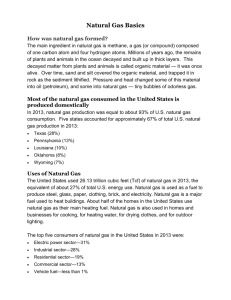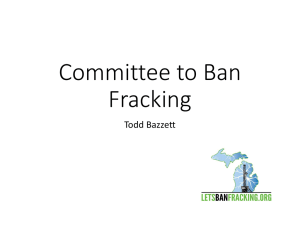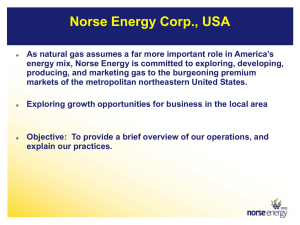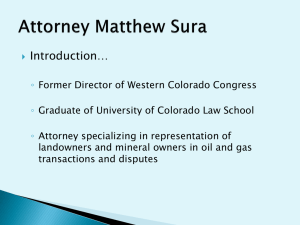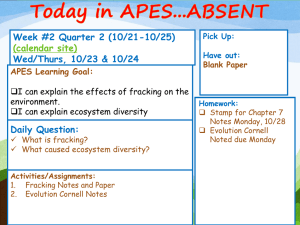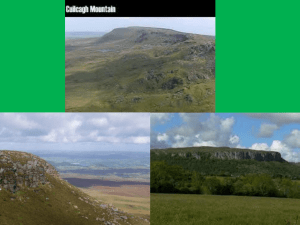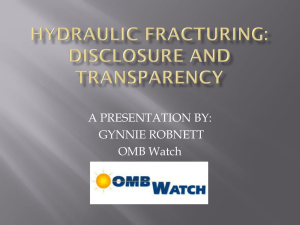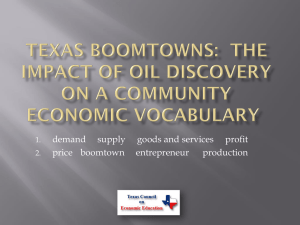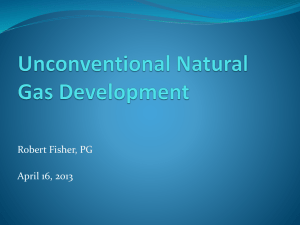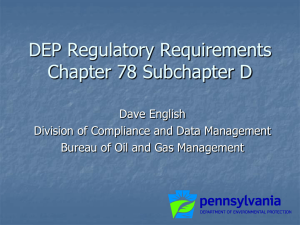Shale Gas - Slow Down Fracking in Athens County (SD
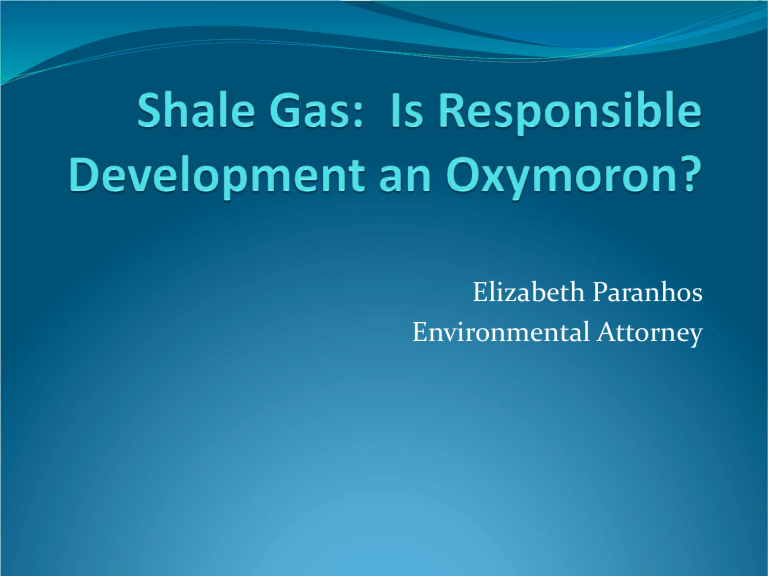
Elizabeth Paranhos
Environmental Attorney
Overview
Game Changer?
Real Concerns
Risk Management
Crisis or opportunity?
•
•
•
•
•
Game Changer?
On March 31, 2011 President Obama declared that
“recent innovations have given us the opportunity to tap large reserves-perhaps a century’s worth” of shale gas.
Shale gas was less than 2% of total U.S. energy production in 2001. Now it is approaching 30% and anticipated to equal nearly 50% by 2035.
Domestic energy source—reduced energy independence. Cheap $4 gas.
Jobs.
Cleanest burning fossil fuel. Is it?
Ground Truthing
LCA-the science is still out. Howarth Study is on the high end. Recent National Energy Technology
Laboratory study. Emissions 42 to 53 percent lower than coal based electricity.
NREL JISEA harmonization study out spring 2012.
What about energy efficiency, renewables? Truth is gas is here to stay.
Economic prosperity, energy independence, drilling, cannot come at expense of human health and environment
Risk Management
How do we protect our air, water, communities, farms, and ecosystems?
Air Pollution
Oil and gas activities are the single largest source of methane emissions in the United States
In 2009, the methane emitted from oil and gas activities equaled approximately 328 million metric tons of carbon dioxide equivalent (MMT CO
2 e). This figure is roughly equivalent to the carbon dioxide emissions emitted from 78 coal-fired power plants.
Potent GHG. Over a 100-year period, methane has a warming potential 25 times that of carbon dioxide. Over
20 years, 72 times more effective. Short life span.
Contributes to background levels of ozone-also a GHG.
Waste from venting, flaring, fugitives
Inefficiencies and lost product
According to a 2010 Government Accountability Office report “around 40% of natural gas estimated to be vented or flared on onshore federal leases could be economically captured with currently available control technologies.”
Such reductions, if accomplished, could increase federal royalty payments by $23 million annually.
Technologies and practices to eliminate this waste are available and often result in immediate or short-term payback due to increased gas sales.
Ozone
Ozone causes suite of health impacts including respiratory ailments and premature mortality
NOx and VOCs are released in abundance from natural gas activities
NOx and VOC emissions from gas production in the
Barnett Shale are comparable to the combined emissions from all the cars and trucks in the Dallas
Forth-Worth metro area.
Deterioration air quality previously pristine areas
Ground-level ozone
Winter-time ozone exceedances have occurred in Wyoming near the Pinedale-Anticline natural gas field
Air toxics
Air toxics cause suite of illnesses including cancer
Studies conducted at various locations in Texas and
Colorado identified high levels of HAPs including benzene, a known carcinogen, at oil and gas exploration and production sites
Benzene detected above TCEQ’s long-term, health-based comparison value of 1.4 ppb
11 of 32 unique areas sampled, most containing or in close proximity to residences
One fenceline site reached 1,100 ppb
EPA Action
EPA recently proposed suite of standards to reduce toxic and VOC emissions. Substantial methane cobenefits. Rules due to take effect April 3, 2010.
Scope of rules cover most significant sources of emissions
Ohio General Permit for new production wells.
Controls for dehys, tanks, combustion devices, equipment and pipeline leaks. Not to wells during drilling or fracturing phase because are temporary.
Water concerns.
Do residents have reason to be concerned?
Federal Drinking Water Regulatory Regime
(for most industries)
In 1974, the Safe Drinking Water Act (SDWA) was enacted
The EPA’s Underground Injection Control (UIC) Program, under the SDWA, protects underground sources of drinking water
(USDWs) from fluids injected into the ground for storage, disposal or enhancing oil and gas recovery.
In 1997, the U.S. Court of Appeals for the 11th Circuit (Atlanta) ordered the EPA to regulate hydraulic fracturing under the Safe
Drinking Water Act. This decision followed a 1989 CBM fracturing operation in Alabama that landowners say contaminated a residential water well. The court determined that “injection,” as used in the SDWA, means the act of “forc[ing] (a liquid) into a passage, cavity, or tissue.” Legal Environmental Assistance
Foundation, Inc. v. EPA, 118 F.3d 1467, 1474 (11 th Cir. 1997).
The “Haliburton Exemption”
While most underground injections of chemicals are subject to the protections of the
Safe Drinking Water Act (SDWA), Congress in 2005 exempted hydraulic fracturing as
“the underground injection of fluids or propping agents (other than diesel fuels) pursuant to hydraulic fracturing operations related to oil, gas, or geothermal production activities” from the Act’s most protections. Energy Policy Act of 2005, Section 322.
Exception: if diesel fuel is used as part of fracking, operator must obtain a permit.
Furthermore, the injection of frack fluids, for storage purposes, is subject to the UIC program, but is permitted into Class II wells rather than Class I because drilling fluids and produced water are not considered hazardous under RCRA. Exception: diesel fuel.
Real Risks?
DOE Shale Gas Subcommitte determined risk of frac fluids leaking into drinking water is slim provided large depth of separation between producing zone and drinking water source.
Surface spill migration into shallow drinking water formation is however real concerns, as is methane migration due to poor well construction.
PA Department of Environmental
Protection
What’s in frack fluids?
Fracking fluids are also exempt from disclosure requirements that would require oil and gas companies to disclose to the public and regulators the nature and concentrations of chemicals used in fracking.
Frac fluid is mixture of water, sand and chemicals.
Human and animal health issue. Need immediate access to info.
Disclosure: A Modest Proposal
Full disclosure of all fracking constituents –
• Voluntary self-disclosure is no substitute for mandatory disclosure under an oversight regime that ensures accuracy of the disclosure and appropriate penalties for mis-statements.
• A voluntary program offers little or nothing in the way of peace of
mind or assurances for residents, or water providers.
• Companies could opt out as fast as they are currently opting in.
• Reporting is a disincentive to use toxic chemicals and push companies to be safe, towards industry-wide adoption of safe fracking substances.
• MSDS not enough. Both composition and concentrations
• Wyoming has model rule-Public disclosure of everything but proprietary. Latter disclosed to state.
“Green” Frac fluids
Companies should use inert, environmentally safe constituents.
Public disclosure of contents of frack fluids will help ensure this happens
If Chesapeake’s CEO can drink fluids, all companies should use safe, non-toxic constituents
Legislative fix? FRAC Act?
2009 House and Senate bills to remove regulatory
SDWA exemption and require disclosure
March 2011 Democrats reintroduce FRAC act
April 2011 Dems release frack fluid report identifying
750 toxic chemicals used in fluids
No legislative action expected soon.
EPA action?
The U.S. EPA is investigating whether drilling poses any threats to drinking water. This includes an examination of the chemicals used in fracturing fluids.
Agency officials say they hope to have final recommendations by 2014.
Investigating reports of drinking water contamination in Bradford and Susquehanna PA and prospective study in Washington county PA
DOI
August 2011 BLM announced consideration of new regulations for frack fluid disclosure and best practices re disclosure, well construction, wastewater, protection of drinking water
DOI has duty to manage public lands, including national forests, in manner that protects water resources.
Must also “prevent permanent impairment of the quality of the environment” and “by regulation or otherwise, take any action necessary to prevent unnecessary or undue degradation of the lands.
BLM Regulatory Protections
The scope of review, recommendations and new policies should define the fracking process and associated resource concerns as broadly as possible. For all wells on federal leases, BLM should follow the example of the STRONGER program and cover:
• Baseline surveys
• Casing and cementing plans
• Chemical information availability
• Prior notification of fracking operations
• Pit construction, maintenance and inspections
Source: STRONGER (State Review of O& NG Environmental regulations) PA review
Stronger Protections
• Setbacks from domestic water wells and streams –
¼ or preferably ½ mile
• Knowledge is key: A Comprehensive baseline studies of hydrological conditions, including an assessment of the potential pathways for fluid movement into groundwater, and plans to prevent such movement
• Tracers in fracking fluids to establish whether drilling and development operations are the cause of contaminating water resources.
Well construction
Key to limiting methane migration is proper well completion (cementing and casing) and pressure management (pressure tests of casing and state-ofthe-art cement bond logs). Isolate gas-producing zone from overlaying formations. Sufficient casing to prevent communication between hydrocarbons and aquifers.
Also microseismic surveys to ensure fracturing is limited to gas-producing formations
Proper inspections and regulations are needed.
Susquehanna County,
Pennsylvania
Date: 2009
Company and Nature of Operations:
There were several reports of methane gas migrating to the surface and of drinking water well exploding. Upon testing, the PA DEP found that nine wells contained methane.
Isotopic analysis was conducted by the
PA DEP and it was determined that the gas did indeed originate from a drilling formation of Cabot Oil & Gas Corp.
Susquehanna County,
Pennsylvania
Case Resolution and Current Status: The PA DEP issued
Cabot a notice of violation on February 27, 2009, citing the company’s failure to comply with Pennsylvania’s Oil and Gas Act. The Notice also stated that “[PA DEP’s] investigation revealed that Cabot had caused or allowed gas from lower formations to enter fresh groundwater.”
Cabot must now get all casing and cementing plans approved by the PA DEP. (PA DEP, DEP Continuing
Investigation Into High Methane Levels in Susquehanna
County Wells, PA DEP Daily News Releases, Jan. 23, 2009)
Bradford PA
State fined Chesapeake Energy $1 million for contaminating water supplies of 16 families. Likely cause? Methane migration due to poor casing and cementing that allowed gas to migrate into shallow gas formations and contaminate wells.
Chesapeake agreed to pay for water treatment for the families and stated it has enhanced its well construction and completion designs.
Did not admit liability, however.
State Regulation: Casing
“Surface casing shall be cemented into or through a competent bed and at a depth that will allow complete well shut-in without fracturing the formation immediately below the casing shoe.”
Production casing: “This casing shall be cemented and, when required by the Division, tested for fluid shutoff above the zone or zones to be produced” (CCR § 1722.3)
Must be in compliance with § 3.13 and done “in such a manner that the injected fluids will not endanger oil, gas, or geothermal resources and will not endanger
freshwater formations not productive of oil, gas, or geothermal resources.” (T.A.C. Title 16, Part 1, § 3.46(f))
CO requires requires operators monitor and record bradenhead annulus pressure during fracking to alert them to well construction failures. COGCC Rule 341
Fracking fluid containment ponds: is pitless drilling a better management practice?
Flowback and produced water
Impoundments cause spills and release VOCs
NYS: Impoundments significant source of HAPs
New Mexico: Over half of incidents of ground water contamination due to faulty pits
In Pennsylvania, state authorities were forced to quarantine cattle after a pit leaked into their field, pooling in a smelly pool that killed the grass.
In Colorado, leaky pits with torn liners spilled more than
6,000 barrels of waste, and one leaking pit contaminated drinking water with benzene.
And in Ohio, compromised pit liners and pit wall failures have sent pollution spilling out into the environment.
Solution? Pitless drilling
Storage tanks-reduce likelihood of spills and air toxic emissions
WY requires 98% control of HAPs and VOCs from tanks
CO: 90% pitless operations in both the DJ and Piceance basins as of 2011.
Pitless drilling may not always be an option for horizontal frack jobs-where not feasible, all pits should be lined, fenced, and recycling or injection should be required as much as possible to reduce truck traffic, minimize spills and air pollution.
Multi-well pads encourage recycling. Water should be piped, not trucked, in between wells.
EPA Action
•
•
EPA recently announced rules to regulate wastewater.
Rules will require wastewater meets certain standards before being sent to POTW. Proposed shale rule in
2014.
Also rules for injection of diesel into underground injection wells
Ecosystems
Gas fields fragment the landscape, interfering with migratory routes, breeding, nesting and winter ranges
.
Essential protections
Landscape level planning that provides for connectivity between important corridors and considers cumulative impacts over broad geographic area
Comprehensive drilling plans. Plan must describe wildlife resources and proposed BMPs to mitigate impacts. COGCC Rule 216.
Science-based identification of crucial wildlife habitat and corridors should be developed and disclosed and used to inform CDPs. CO/NM coordination.
Adequate enforcement and monitoring of surface use stipulations, mitigation measures
Wayne and other State Forest
Insist on landscape level planning
Ohio NEPA review?
Adequate mitigation measures to protect streams, wildlife, fisheries.
Setbacks
Baseline monitorin
NSO stips?
Boom Bust Cycle
Then what?
“A growing body of credible research evidence in recent decades shows that resource dependent communities can and often do end up worse off than they would have been without exploiting their extractive reserves”. Cornell Dept. of City and
Regional Planning, CaRDI report. David Kay “The
Economic Impact of Marcellus Shale Gas Drilling:
What Have we Learned? What are the Limitations?”
Who should pay and how much?
Severance tax is a tax imposed on the value of nonrenewable resources that will be used the state from which they are extracted
All states except NY and PA impose severance tax
Bill in PA legislature proposed to impose impact fee on wells and toughen clean water protection laws and penalties for environmental violations.
Severance tax should pay for short and long-term impacts of drilling to avoid undue burden on local communities and governments
Do taxes and regulation deter investment?
WY suggests no. State has some of the most stringent environmental regulations and a severance tax. Over same period of time when WY increased tax rate to approx 50% that of MT, and MT lowered it, the production value (product of price times volume) in
WY was 5 times as high as CO.
WY and CO have experienced considerable growth in gas production, in some cases higher than US overall, despite having some of toughest regs.
Should we follow France?
Estimated 55 municipalities have some ban
Santa Fe ordinance
Pittsburg, Morgantown, and NJ have banned
NY recently lifted ban. No drilling in NYC and
Syracuse watersheds, buffers of 500-4000 ft
Some places are too special
Communities need protections
Know your rights!
Negotiate lease terms.
Lease term?
Access?
Baseline soil, air and water monitoring
Record crop production, animal fertility rates
Require companies clean up and compensate for any contamination
Ohio has mandatory pooling. If acquire 90% of mineral rights, may force owners of 10% to participate.
But no surface access to holdouts.
No mud, no lotus
Where do we go from here?
Stay informed!
Know your rights. Negotiate lease terms
Support tough rules that protect human health and the environment; environmental review state/federal lands
Make injured plaintiff whole. Stronger fines and enforcement
Protect special places and communities: moratorium, setbacks, NSO stipulations
Conserve and reduce energy. Energy independence starts with each one of us
